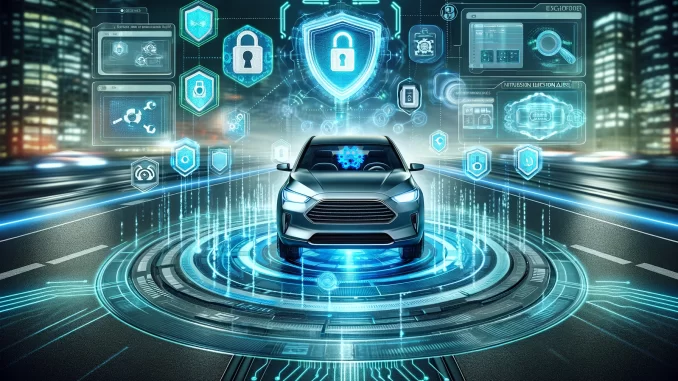
Securing Your Ride: Innovations in Automotive Cybersecurity
As the digital era accelerates, the automotive industry is in a race against time to ensure the cybersecurity of vehicles. Automakers globally are deploying cutting-edge technologies to shield cars from cyber threats. This proactive approach is essential in an age where vehicles are not just means of transport but interconnected digital hubs on wheels. There is a constant war agains automotive hackers.
Innovative Defenses Against Cyber Threats
Automotive giants are investing heavily in robust cybersecurity measures. These include the development of advanced encryption algorithms that safeguard vehicle-to-everything (V2X) communications. Encryption acts as a digital fortress, keeping automotive hackers at bay and ensuring that your car’s conversations remain confidential.
Firewalls: The First Line of Defense
Just like in your computer, firewalls in vehicles act as gatekeepers. By monitoring incoming and outgoing data, they prevent unauthorized access. This ensures that only safe and necessary communications pass through, keeping critical systems secure. Protection from automotive hackers starts here.
Regular Software Updates: Keeping Threats at Bay
Automakers understand the importance of staying ahead in the cybersecurity race. They roll out regular software updates to patch vulnerabilities, much like smartphone manufacturers. These updates are crucial in fortifying the vehicle’s defenses against new and evolving threats.
Intrusion Detection Systems: The Watchful Eyes
To counteract sophisticated cyber attacks, vehicles now come equipped with intrusion detection systems (IDS). These systems continuously monitor the vehicle’s network for signs of unusual activity, ready to respond at the first hint of a threat.
Secure by Design: Building Safety from the Ground Up
The concept of ‘Secure by Design’ is gaining traction. This approach integrates cybersecurity features into the vehicle’s initial design phase, ensuring that every component is built with security in mind. It’s a holistic approach that embeds safety into the very fabric of the vehicle.
Collaboration Across the Board: Industry-wide Efforts
The fight against cyber threats isn’t limited to individual automakers. The industry is witnessing unprecedented levels of collaboration. Automakers, tech companies, and cybersecurity firms are joining forces to develop shared standards and best practices. This collective effort is crucial for creating a unified front against cyber adversaries.
Education and Awareness: Empowering Drivers
Beyond technological solutions, educating drivers plays a pivotal role in cybersecurity. Automakers are rolling out awareness campaigns to inform users about the importance of cybersecurity measures. From the basics of secure Wi-Fi connections to the complexities of phishing attacks, informed drivers are the first line of defense against cyber intrusions.
The Role of Artificial Intelligence and Machine Learning
The adoption of artificial intelligence (AI) and machine learning (ML) in automotive cybersecurity represents a significant leap forward. These technologies enable real-time threat detection and response, adapting to new threats as they evolve. AI and ML can analyze patterns, predict potential vulnerabilities, and automate protective measures, making cybersecurity more dynamic and proactive.
Future-Proofing Vehicles: Beyond Today’s Threats
Looking forward, the integration of emerging technologies such as blockchain into automotive cybersecurity is on the horizon. Blockchain could offer a new level of security for vehicle transactions and data exchanges, ensuring transparency and integrity. As vehicles become more autonomous, the role of blockchain and other innovative technologies will become increasingly important in safeguarding against cyber threats.
A Commitment to Continuous Improvement
The automotive industry’s approach to cybersecurity is not static. It is a continuous cycle of assessment, improvement, and adaptation. Automakers are constantly evaluating the effectiveness of existing cybersecurity measures and exploring new ways to enhance security. This commitment to continuous improvement is essential for staying ahead of cybercriminals in an ever-evolving digital landscape.
Conclusion and Final Thoughts: Driving into a Secure Digital Future
As our vehicles become more connected, the importance of cybersecurity cannot be overstated. The efforts of automakers to enhance cybersecurity are a crucial step towards a future where drivers can enjoy the benefits of advanced technology without compromising on safety or privacy. With ongoing innovation, collaboration, and education, the automotive industry is steering towards a future where cybersecurity is as integral to a vehicle as its engine or wheels and that automotive hackers should take on a new hobby.
The journey towards automotive cybersecurity is an ongoing one, but with each step forward, we move closer to a world where the road is not just about getting from point A to B, but doing so securely in the digital age. Automakers’ proactive stance on cybersecurity ensures that as the landscape of threats evolves, so too will the defenses protecting our vehicles, making the future of driving safer and more secure for everyone.
As automakers innovate, the future of automotive cybersecurity looks promising. These measures not only protect vehicles from cyber threats but also safeguard the privacy and safety of passengers. With the industry’s continuous efforts, drivers can look forward to a safer, more secure automotive future.
By prioritizing cybersecurity, automakers are not just enhancing vehicle safety; they are preserving the trust and confidence of drivers worldwide. This commitment to cybersecurity is a testament to the industry’s dedication to advancing automotive technology while ensuring the highest safety standards.




Be the first to comment